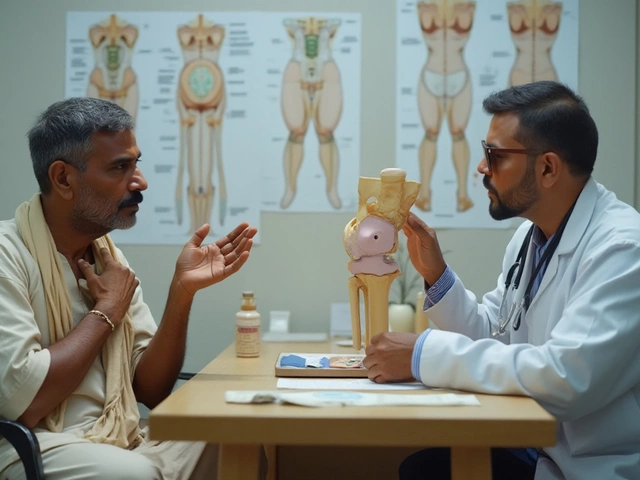People hear “knee replacement” and imagine weeks trapped in bed. That’s not how things work these days. In most hospitals, the plan is to get you up and moving on the very same day of surgery, or by next morning at the latest. Lying in bed too long only makes things worse—think swollen legs, stiff joints, and a lot more pain.
Your doctor and physio don’t expect you to walk a marathon right away. You might stand up with a walker just for a few steps at first, and sometimes that’s just from the bed to a chair. Small moves count, and every step helps recovery. If you’re picturing days on end with only bathroom breaks, you can relax—real bed rest after knee replacement is short, and most people spend more time sitting in a comfy recliner than lying flat in bed.
- What Happens Right After Knee Replacement Surgery?
- Actual Bed Rest Time: Myths vs. Facts
- Getting Moving: When and How
- Tips for a Smoother At-Home Recovery
What Happens Right After Knee Replacement Surgery?
Waking up from knee replacement surgery, you’ll feel a bit groggy and probably have a big bandage on your knee. Don’t stress—this is normal. Nurses will check your blood pressure, make sure you’re comfortable, and ask about your pain levels. Expect a painkiller drip or injection. They’ll keep a close eye on your vital signs for the first few hours.
The name of the game is to get you up and moving as soon as possible. You may see a physical therapist as soon as a couple hours after surgery. This is when they’ll gently help you stand or even take a few careful steps using a walker. Sounds fast, but research shows early movement leads to better outcomes and less risk for issues like blood clots.
The first day isn’t about walking unassisted—the goal is just to move a little. You’ll probably:
- Slide your feet up and down the bed (called ankle pumps) to keep blood flowing
- Bend and straighten your brand new knee just a bit
- Sit up in bed or get into a nearby chair with help
Some people stay in the hospital 1-3 days after a knee replacement, but more hospitals now do “same day” discharge if everything looks good. If you’re up, eating, and showing you can manage a bathroom trip safely (even wobbly), you might be on your way home within 24 hours.
| What Happens | When |
|---|---|
| Wake up from surgery | Immediately after |
| Pain and vital signs checked | First few hours |
| Physical therapy visit | Within 6-12 hours |
| First walk with help | Same day or next morning |
| Possible discharge | Day 1-3 post-surgery |
If you’re worried about being “bedridden,” don’t be. Hospitals want you out of bed quickly. Early movement kickstarts your recovery time and helps you get your independence back faster.
Actual Bed Rest Time: Myths vs. Facts
This is where things usually surprise people. The old idea that knee replacement means lying in bed for days is just not true anymore. Actual bed rest is now super short—most people are out of bed within 12 to 24 hours after surgery. Unless there’s a big medical hiccup, doctors want you sitting or even standing the same day if possible.
Here’s a quick breakdown on what really happens:
- Same Day: You might swing your legs off the bed and stand with support, sometimes walk a few steps with a walker.
- Day One: Physical therapy usually starts right in the hospital room. Nurses help you get up, sit in a chair, and walk a little.
- After Day One: Most folks spend most of their daytime in a chair or walking with help. Actual time spent lying flat in bed is just for sleeping at night or short rest.
Want numbers? A study from 2023 showed that 8 out of 10 people who had a knee replacement were up and moving within the first 24 hours. This early movement isn’t just to show off—it’s proven to help cut down the risk of clots, speed up healing, and make rehab smoother.
| Day After Surgery | Average Bed Rest Time (hours) (not counting sleep) |
|---|---|
| Day 0-1 | 2-4 (short naps) |
| Day 2 | 1-2 |
| Day 3+ | Less than 1 |
So, if you’re dreading weeks in bed—good news, the recovery time for just “lying around” is mostly a thing of the past. The focus now is safe, steady movement, not old-school bed rest.

Getting Moving: When and How
Most folks think bed rest is what you need after a knee replacement, but the reality is, doctors want you moving as soon as possible. Nearly every surgeon and hospital now follows “enhanced recovery” routines, which means you’ll start simple movements within hours. Lying around for days? That’s old-school thinking and can actually slow down your recovery.
Usually, your first big move happens on the day of surgery or the next morning. With help from a physiotherapist, you’ll swing your legs over the side of the bed and stand up. It’s not about walking laps right away—just getting those muscles to remember their job. Some folks manage a few steps with a walker the very first time. Worried about pain? Medicine kicks in before you get moving, and the therapists know exactly how to keep things safe.
Here’s how it usually looks:
- 0-24 hours after surgery: Stand or walk a few steps with assistance.
- Day 2-3: Walk a little farther—maybe to the hallway or bathroom. Start basic knee bends and foot pumps.
- End of week 1: Most people can move around the home, with a walker or crutches, and do simple exercises.
| Time After Surgery | Typical Activity |
|---|---|
| First 24 hours | Sitting, standing, and short walks with help |
| 2-3 days | Short walks in hospital hall, stairs practice |
| End of week 1 | Walking at home, more exercises |
| 2-6 weeks | Walking without help, light household tasks |
The most important thing? Listen to your therapy team and don’t rush. Skipping early movement makes everything harder later. Aditya kept asking me how soon he could play football with me again—the truth is, small daily moves now mean more freedom sooner.
Tips for a Smoother At-Home Recovery
Getting home after a knee replacement is a relief, but the real work starts there. Recovery moves faster when your space is ready and routines are simple. You want to focus on healing, not stressing over where to put your walker or how to reach snacks.
- Set up a "recovery zone" close to the bathroom and kitchen. Choose a firm chair with arms. Stash remote, water, phone, and meds within reach.
- Stick to your physical therapy plan every day. Missing a single session can slow things down. Those stretches and short walks matter more than you think.
- Manage swelling with ice packs and by propping your leg up using pillows. Try to keep your ankle above your heart for about 20 minutes, three times daily.
- Wear shoes with good grip. It probably sounds boring, but slipping is your knee’s worst enemy right now.
- Prep meals ahead or ask for help with food. Frozen healthy meals you can just reheat are lifesavers when standing in the kitchen is tough.
- Use mobility gear—don’t ditch your walker or cane too early, even if you feel tough. Gradually swap to a cane when your prep team (physio or doc) says you’re ready.
- Check for infection daily. Take a look at your incision and call your doctor right away if you notice redness, oozing, or a new fever. Sounds obvious, but it’s easy to ignore little changes until things get worse.
Here’s what people usually deal with at home in terms of recovery time:
| Milestone | Average Time After Surgery |
|---|---|
| Walking with walker | 1-3 days |
| Showering (with help) | 2-5 days |
| Stairs (with support) | 7-10 days |
| Outdoors/short car ride | 2-3 weeks |
| Back to light chores | 3-6 weeks |
One thing nobody tells you: Rest is good, but too much bed rest is not. Make it a goal to stand up at least once an hour during the day, even for just a minute. That’s the sweet spot—resting enough but giving the new knee action so it doesn’t get stiff. Ask family for help; even my kids, Aditya and Sanjana, used to compete to bring me ice packs or refill my water so I wouldn’t have to limp to the kitchen. Recovery is easier when you let people pitch in.





